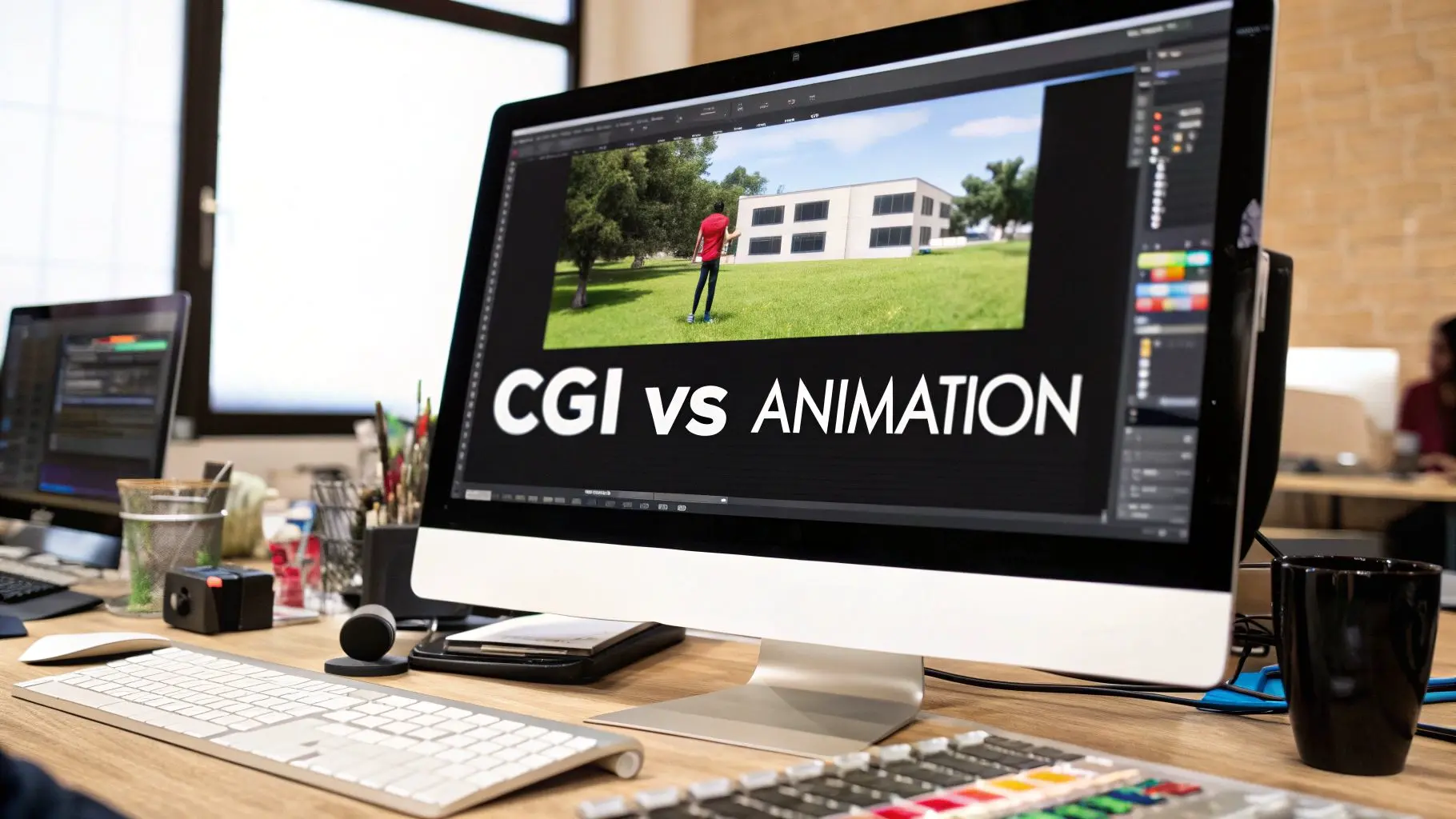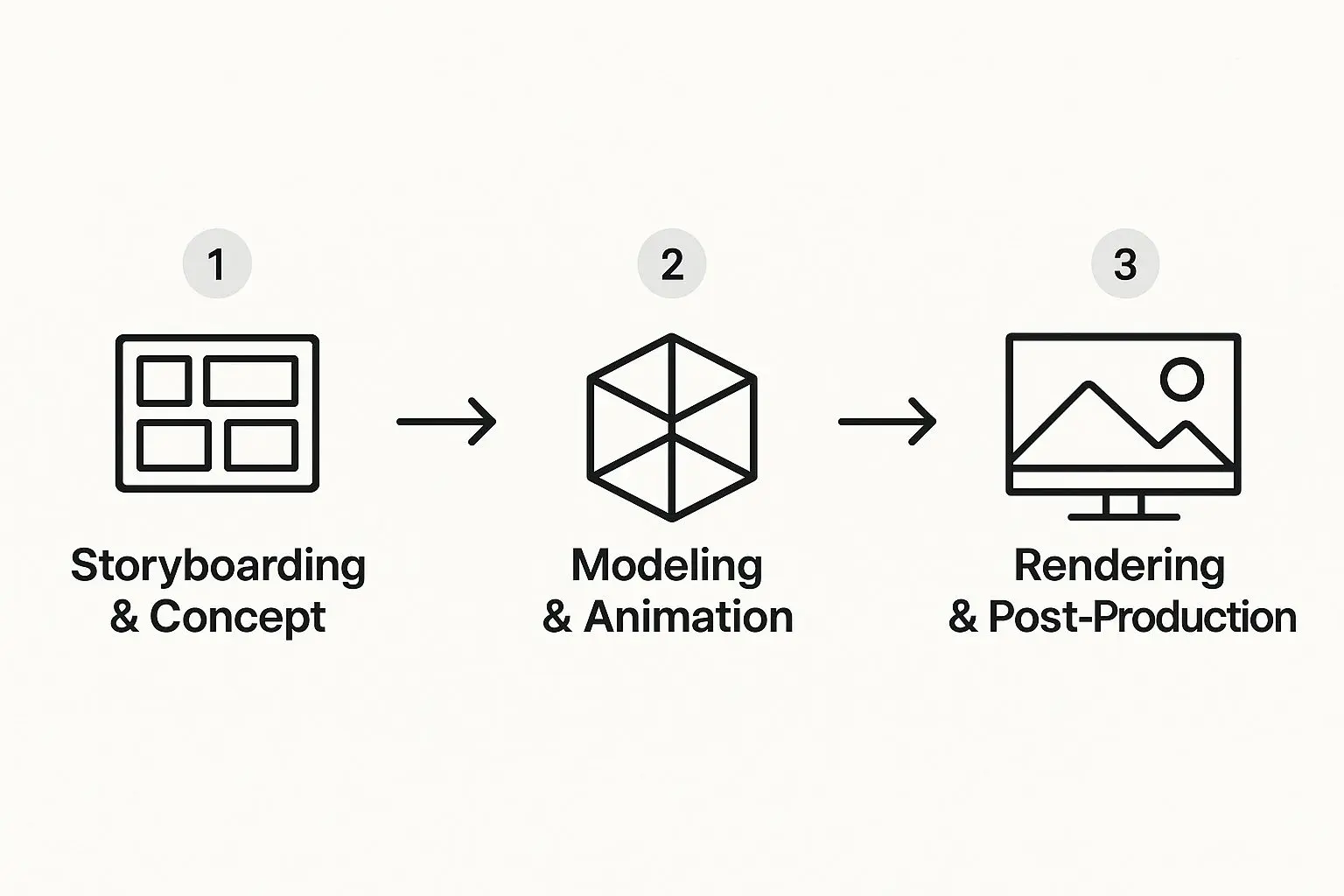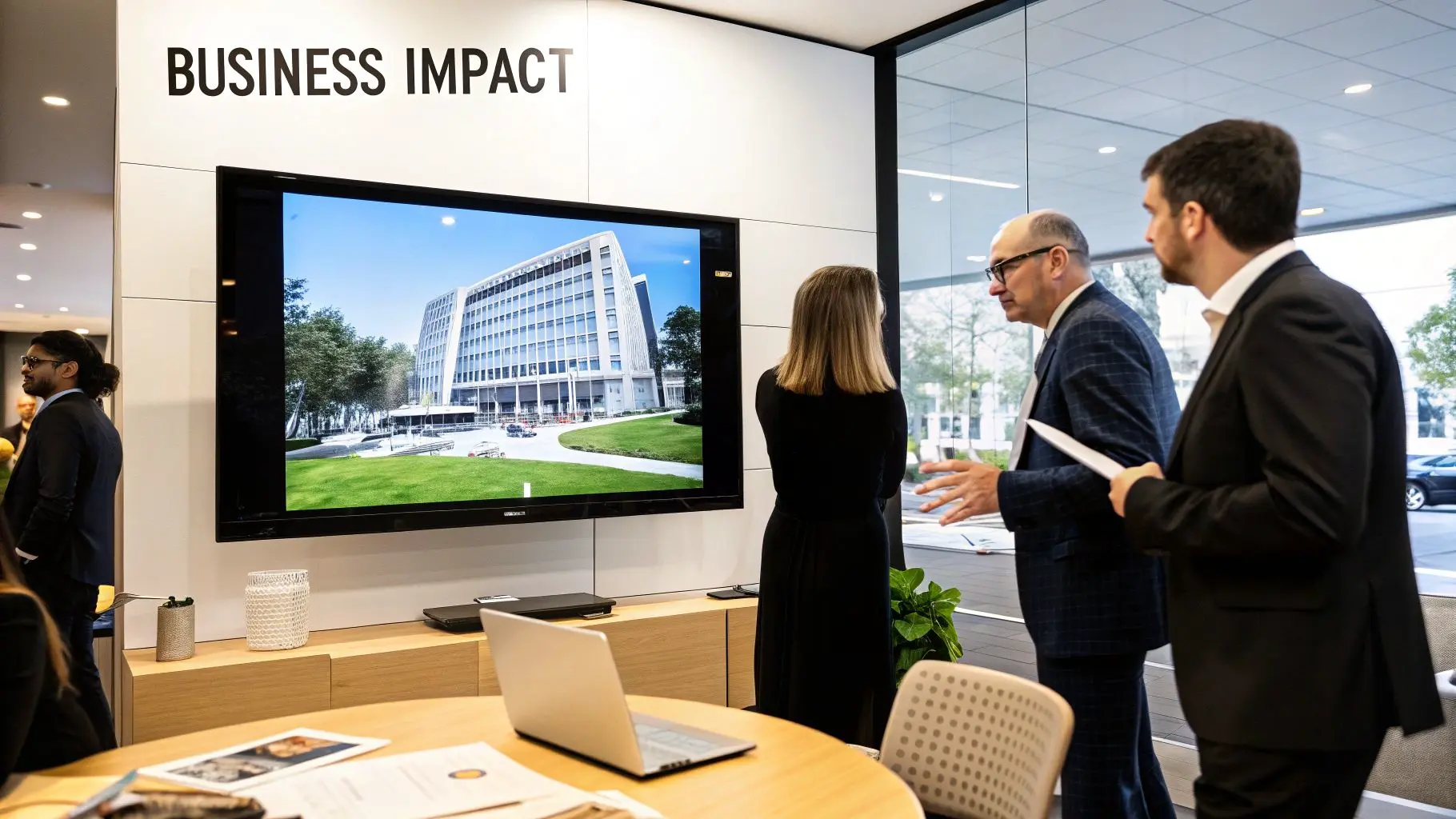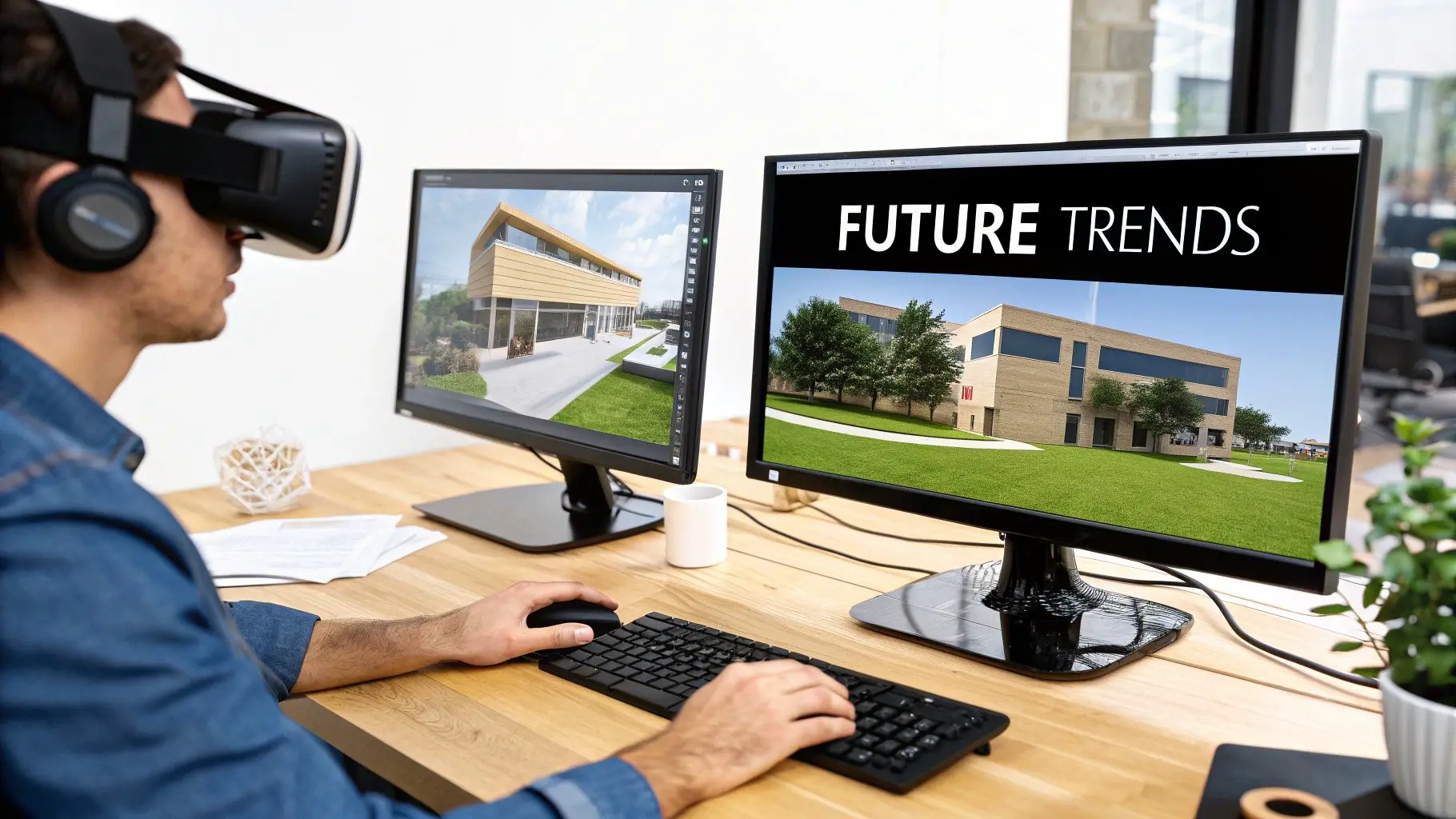CGI and Animation Explained for Modern Brands
It’s easy to get the two mixed up, but the relationship between CGI and animation is actually pretty simple. Think of it this way: CGI is the technology, and animation is the art form. Computer-Generated Imagery (CGI) is the digital toolkit, the virtual cameras, paintbrushes, and modelling clay. Animation is the creative act of using that toolkit to breathe life into something.
Unpacking the Core Concepts

People often use the terms interchangeably, but they represent two very different parts of the creative pipeline. Getting the distinction right is key to understanding how nearly all modern visual media gets made, from the latest superhero blockbuster to your favourite advert. CGI is a massive umbrella term for any image created with computer software. Crucially, it doesn't have to move. That stunningly photorealistic car in a magazine ad? If it was built entirely on a computer, that's CGI, but it isn't animation. Animation, on the other hand, is all about creating the illusion of movement. It's the specific technique of showing a sequence of images, or frames, in quick succession. This can be done the old-school way with hand-drawn cells or, as is most common today, digitally using CGI.
Defining Their Roles
When a studio like Pixar makes a film such as Toy Story, they are using CGI technology to perform the art of animation. Every character, prop, and backdrop is a piece of CGI. Animators then step in to manipulate these digital assets frame-by-frame, making them walk, talk, and show emotion. Let's break their roles down:
- •Computer-Generated Imagery (CGI): This is the "what." It refers to the digital assets themselves, the 3D models, textures, and environments built inside a computer.
- •Animation: This is the "how." It's the actual process of manipulating those CGI assets over time to create movement and tell a story.
In short, nearly all modern 3D animation is a form of CGI, but not all CGI is animation. This distinction is so important because it cleanly separates the tool from the craft.
From Static Images to Moving Worlds
The journey from a motionless CGI model to a fully animated character is a fascinating and complex one. It starts with a digital artist building a 3D model, which is a bit like creating a virtual sculpture. This model is then given a digital skeleton, known as a "rig," which gives animators the control points they need to pose and move it. Finally, the animators take over to bring the static model to life. They painstakingly craft its performance one frame at a time, infusing it with personality. This powerful marriage of CGI and animation is what drives the visuals in everything from Saturday morning cartoons to complex engineering simulations.
CGI vs Traditional Animation at a Glance
To really nail down the difference, it helps to see how modern CGI-based animation stacks up against the classic, hand-drawn methods we all grew up with.
| Aspect | CGI | Traditional Animation |
|---|---|---|
| Core Tools | Software like Maya, Blender, rendering engines | Pencils, paper, lightboxes, paint, acetate cels |
| Process | Digital modelling, rigging, texturing, animating, rendering | Storyboarding, drawing, inking, painting, filming cels |
| Flexibility | Highly flexible; easy to change camera angles, lighting | Rigid; changes require redrawing entire sequences |
| Initial Cost | High software and hardware costs | Lower initial tool costs, but high labour costs |
| Labour | Requires specialised technical and artistic skills | Extremely labour-intensive, requires armies of artists |
| Output | Can be photorealistic or stylised (2D or 3D) | Typically has a distinct, hand-crafted 2D aesthetic |
| Key Example | Avatar (photorealistic), Spider-Man: Into the Spider-Verse (stylised) | Disney's Snow White, The Lion King (1994) |
While the tools and techniques are worlds apart, the fundamental goal remains the same: to tell a compelling story through the magic of movement. CGI has simply given artists an incredibly powerful new set of pencils.
How the UK Became an Animation Powerhouse
The UK's standing as a global animation leader didn't just happen overnight. It was built on a rich heritage of character-driven storytelling, long before digital tools were even a thing. Think of iconic stop-motion classics like Wallace & Gromit or Shaun the Sheep from Bristol’s own Aardman Animations. They established a creative DNA that was uniquely British , quirky, warm, and built on incredible craftsmanship. This strong foundation in traditional animation gave UK studios a massive head start when the industry began its shift to digital. Instead of just jumping on the tech bandwagon, British artists did something smarter. They blended their classic storytelling skills with the powerful new toolkit of CGI. This fusion of old and new, art and technology, allowed them to create work that felt both fresh and full of the personality that continues to set the UK apart.
The Rise of Creative Hubs
This creative energy isn’t just bubbling away in one place; it’s thriving in specialised hubs dotted across the country. London is still a global heavyweight for high-end visual effects and commercials, while Bristol remains the undisputed world leader in stop-motion and character-led stories. Head north, and you'll find cities like Manchester have become dynamic centres for everything from beloved children's television to the real-time animation needed for games and immersive experiences. If you're curious about the talent in this region, you might be interested in our guide to the best animation studios in Manchester.
The UK’s animation sector is powered by a unique blend of ironic humour, design excellence, and world-class technical artistry that continues to distinguish it from global competitors.
This decentralised ecosystem fosters an amazing diversity of specialisms and talent. From Cardiff to Dundee, studios are pushing the creative envelope, adding to a vibrant national industry. It’s this creative firepower that has propelled British-made series like Peppa Pig and Hey Duggee to phenomenal international stardom. Peppa Pig alone is now broadcast in roughly 180 countries.
A Thriving Industry with Global Reach
The UK's impact is backed by some seriously impressive numbers. The animation workforce had swelled to over 12,000 professionals by 2022, a clear sign of the high demand for British creative talent. These skilled artists and technicians are the backbone of an industry that excels at creating intellectual property that travels the globe. The country's reputation for quality, reliability, and creative spark makes it a top destination for international co-productions and major broadcast commissions. It’s this powerful combination of heritage, talent, and technical wizardry that has cemented the UK's status not just as a player, but as a true powerhouse in the world of CGI and animation.
Your Guide to the Animation Production Pipeline
Turning a simple idea into a polished piece of animation isn't some chaotic artistic scramble. It's actually a highly organised and collaborative journey. The entire process follows a structured path known as a production pipeline , think of it as the assembly line for creative work, making sure every stage is completed in just the right order to deliver a high-quality final product. It’s a bit like building a house. You wouldn’t dream of putting up the walls before the foundation is properly poured and set. Animation is no different; foundational steps like storyboarding have to be locked in before you can even think about building characters and worlds. Every single stage builds directly on the work of the last. The infographic below breaks down the three core phases of this journey, showing how a project moves from its initial spark of an idea right through to final delivery.

This visual really hammers home the linear progression. Each major phase needs a final sign-off before the next one can kick off, a crucial step that prevents costly mistakes and frustrating rework later on.
Pre-Production: Where Ideas Take Shape
This is the all-important planning phase. Long before a single 3D model gets built, the creative and management teams get together to map out the entire project from start to finish. This stage is all about asking , and answering , every critical question to forge a solid blueprint. A few key steps make this happen:
- •Storyboarding: This is basically a sequence of drawings, much like a comic book, that visually outlines the whole animation. It's where we set the camera angles, character staging, and core actions.
- •Animatics: Here, the storyboard panels are timed out and set to a rough audio track. The result is a basic, moving version of the animation that helps establish the pacing and flow of every scene.
- •Design: This is where the visual identity gets locked down. Artists create stunning concept art, character designs, and environmental layouts that will define the project's final look and feel.
A strong pre-production is the secret sauce for a smooth project. It guarantees everyone is working towards the same creative vision and helps keep the time and budget in check. To see how these early stages come together, check out the detailed breakdown in our UK guide on how to create 3D animation.
Production: Bringing the Vision to Life
With the blueprint finalised, the production phase kicks off. This is where the digital assets are actually created and the animation happens. It’s easily the most labour-intensive part of the pipeline, bringing together a wide range of talented technical artists. The core production stages look like this:
- 3D Modelling: Artists build the characters, props, and environments in 3D software, creating the digital "sculptures" that will populate the world.
- Texturing: Surfaces are digitally painted with colour, patterns, and material properties, like shiny metal or rough wood, to give the models a realistic or stylised appearance.
- Rigging: A digital "skeleton" is built inside each character model. This rig gives animators the controls they need to move the character's limbs, face, and body.
- Animation: Animators take the rigged models and breathe life into them, creating the performance frame by painstaking frame.
Post-Production: The Final Polish
Once all the scenes are animated, they head into post-production. This is where all the final touches are added, bringing everything together into a cohesive, polished final piece that’s ready for the world.Post-production is where individual shots are transformed into a seamless cinematic experience. It involves compositing, sound design, and colour grading to achieve the final, broadcast-ready look.Tasks at this final hurdle include rendering the final images, compositing different visual layers together, adding visual effects (VFX), performing colour correction to get the mood just right, and mixing the final sound design.
How Businesses Use CGI and Animation to Win
 Far beyond the silver screen, CGI and animation have become seriously powerful tools for modern businesses, helping them solve tricky problems and create real, tangible value. Their magic lies in making the abstract concrete, the invisible visible, and the complex simple. From launching a new product to running internal training, these technologies give companies a visual language that cuts right through the noise. They make it possible to explain intricate ideas, showcase future possibilities, and connect with audiences on a much deeper, more emotional level.
Far beyond the silver screen, CGI and animation have become seriously powerful tools for modern businesses, helping them solve tricky problems and create real, tangible value. Their magic lies in making the abstract concrete, the invisible visible, and the complex simple. From launching a new product to running internal training, these technologies give companies a visual language that cuts right through the noise. They make it possible to explain intricate ideas, showcase future possibilities, and connect with audiences on a much deeper, more emotional level. Driving Engagement in Marketing and Advertising
In marketing, animation's main job is to grab attention and tell a story that sticks. It could be a charming 2D explainer video that breaks down a new software service, or a hyper-realistic 3D product rendering for an e-commerce site. Either way, animation helps brands stand out from the crowd. This is especially true in today's packed digital world. Animated content gives marketers total creative freedom over branding, messaging, and tone, making sure the final piece hits all the right strategic notes. It’s an incredibly versatile medium that works everywhere, from broadcast TV ads to bite-sized clips for social media.Visualising the Unbuilt in Architecture and Engineering
For architects and engineers, CGI is much more than just a fancy presentation tool, it’s a fundamental part of the design and validation process. Photorealistic architectural visualisations, or "archviz," let stakeholders walk through a building long before a single brick has been laid. These immersive walkthroughs and detailed renders help achieve several crucial business goals:- •Securing Investment: They help developers and clients truly see the final project, making it far easier to get financial backing and planning approval.
- •Identifying Flaws: CGI models can flag design issues or structural clashes early on, saving a huge amount of time and money on expensive real-world fixes.
- •Marketing Properties: High-quality visuals are essential for selling properties off-plan, giving potential buyers a compelling and accurate glimpse of their future home or office.
Enhancing Safety and Understanding in Technical Fields
The use of CGI and animation doesn't stop there; it reaches deep into highly specialised sectors like medicine and manufacturing. Surgeons can now practise complex procedures on realistic digital models, which helps reduce risk and improve patient outcomes. In the UK, the animation scene is increasingly dominated by 3D CGI, mirroring a global trend where a staggering 85% of animation is now computer-generated. This technical shift supports a whole host of applications beyond entertainment, including advanced training simulations and the kind of immersive virtual reality experiences vital for business innovation. Learn more about the latest video animation statistics. These simulations allow engineers to test prototypes under extreme conditions without any physical risk or cost. By creating safe, repeatable virtual environments, businesses can train staff more effectively, sharpen up safety protocols, and speed up innovation, all demonstrating a very clear return on investment.
Future Trends Shaping the Animation Industry

The world of CGI and animation is moving at a blistering pace, with new technologies constantly pushing the boundaries of what’s possible. The changes we’re seeing aren’t just small tweaks to the production pipeline; they are game-changers that promise to make animation faster, more interactive, and more accessible than ever before. Two major forces are at the heart of this evolution: real-time rendering and generative artificial intelligence (AI). These aren't just pie-in-the-sky concepts from a sci-fi film. They are practical tools being woven into studio workflows right now, completely changing how stories are brought to life.
The Rise of Real-Time Rendering
Traditionally, rendering, the process of turning 3D models into the final 2D images you see on screen, has been the single biggest bottleneck in animation. It could take hours, sometimes even days, to render one complex frame. This made creative changes slow, painful, and very expensive. Real-time engines like Unreal Engine and Unity have completely flipped that on its head. Originally built for video games, these platforms can generate incredibly high-quality images in an instant. This gives directors and artists immediate feedback, letting them play around with lighting, camera angles, and effects on the fly without the agonising wait. This shift is huge for a few reasons:
- •Faster Iteration: Creative decisions can be made in minutes instead of days, leading to a more polished and dynamic final product.
- •Interactive Content: It swings the door wide open for immersive VR experiences, interactive films, and virtual productions where CGI is blended seamlessly with live-action footage as it's being filmed.
- •Cost Efficiency: By slashing render times, studios can pour more of their budget into the creative side of the project.
If you’re keen to get into the nuts and bolts, our comparison of Unreal vs Unity for real-time animation offers some great insights for producers weighing up their options.
Generative AI as a Creative Partner
Artificial intelligence has moved from a buzzword to a genuinely powerful creative assistant. Generative AI tools are now being used to speed up some of the most time-consuming jobs in the animation pipeline, from creating initial concept art to automating character rigging and motion. Of course, this technology is a bit of a double-edged sword. Here in the UK, the animation industry is busy figuring out both the opportunities and the challenges that AI brings. Recent data shows that 44% of studios have already started using generative AI for tasks like 3D modelling. Some estimates suggest AI could affect as many as 40% of character and environment design jobs. While this promises massive efficiency gains, it also starts some important conversations about artistic integrity and the future role of the animator.
The goal isn't for AI to replace artists, but to give them a serious upgrade. By handling the repetitive, technical jobs, AI frees up animators to focus on what humans do best: storytelling, performance, and hitting those emotional notes.
Looking ahead, innovations like those used for creating futuristic animations are setting a new standard for visual storytelling. The future of animation is shaping up to be a powerful blend of human creativity and intelligent technology, where tools don't limit imagination but expand it in exciting and unexpected ways.
Common Questions About CGI and Animation
To wrap things up, let's tackle a few of the most common questions that pop up when people talk about CGI and animation. We'll cut through the jargon and give you some clear, straightforward answers.
What Is the Difference Between CGI and VFX?
It’s easiest to think of it like this: CGI (Computer-Generated Imagery) is the ingredient, while VFX (Visual Effects) is the finished dish. CGI is any image created entirely on a computer, like an animated character or a fantasy world. VFX, on the other hand, is the much broader process of mixing those CGI elements with live-action footage. So, when you see a CGI dragon soaring over a real-life castle in a film, that’s a visual effect. All CGI used in live-action is a type of VFX, but VFX also covers other techniques, like compositing, which is the art of blending all the digital and real-world layers together seamlessly.
How Long Does It Take to Create an Animation?
That's the million-dollar question! The timeline for an animation project can vary wildly depending on its complexity, style, and length. There’s no single answer, but here’s a rough idea:
- •Simple Motion Graphics: A punchy, 30-second video for a social media ad could be turned around in a couple of weeks.
- •Character-Driven Shorts: A high-quality, 3-minute animated piece with characters and a story? You’re likely looking at several months from the initial idea to the final export.
- •Feature Films: This is the big one. A full-length animated movie can take years to make, often involving hundreds of artists working in a highly coordinated pipeline.
The biggest time sinks are always the level of detail, the complexity of the character movements, and the sheer processing power needed to render the final, high-resolution images.
Should I Choose 2D or 3D Animation for My Project?
The right choice comes down to your brand, your message, and your budget. Each style has its own unique flavour and is better suited for different goals.
2D animation is fantastic for stylised, graphic, and character-focused stories, often being more cost-effective. In contrast, 3D animation, a form of CGI, is the champion for creating realistic visuals, detailed product demonstrations, and immersive worlds with dynamic camera movements.
A sleek tech company, for example, might gravitate towards polished 3D to show off its products. A non-profit telling an emotional story, however, might find that the authentic, handcrafted feel of 2D animation builds a much stronger connection with its audience.
What Skills Do I Need to Be a CGI Animator?
A great CGI animator is a blend of artist and technician. It's a field where pure creativity has to go hand-in-hand with software mastery. On the artistic side, you absolutely need a deep understanding of the core animation principles, things like timing, spacing, and appeal. Without those fundamentals, the work will feel lifeless. A good eye for composition, colour, and storytelling is also essential for creating performances that an audience will connect with. Technically, you’ll need to get comfortable with industry-standard software like Maya, Blender, or Cinema 4D. Many animators also specialise in specific parts of the pipeline, such as:
- •Character Rigging: Building the digital "skeletons" that let characters be posed and moved.
- •Texturing and Lighting: Creating the look and feel of every surface and setting the mood of a scene.
- •Real-Time Engines: Using platforms like Unreal Engine for interactive experiences and much faster rendering workflows.
At Studio Liddell, we bring ideas to life with world-class animation and immersive content. With a broadcast pedigree stretching back to 1996, we have the expertise to manage your project from the first pitch to final delivery. Book a production scoping call